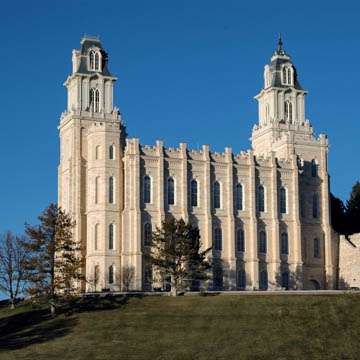You are here
Manti Utah Temple
The Manti Utah Temple in Sanpete Valley is a monumental example of the temples built by the first generation of Mormon settlers in nineteenth-century Utah. Church architect William H. Folsom designed it according to a general sketch provided by the second Mormon president, Brigham Young. According to Mormon tradition, Young’s design and choice of site was guided by the angel Moroni, a warrior who died in a battle between two pre-Colombian civilizations and became the guardian angel of the source material of the Book of Mormon. Like other Mormon temples, the Manti Utah Temple was built entirely by volunteers from the Mormon community, which included a number of trained and highly skilled craftsmen. Members of the church who were unable to physically help build the temple paid a nominal but mandatory fee during the years of its construction. The temple stands as a symbol of the collective labor and religious commitment of the Mormon community.
The temple was erected on a hilltop site from which much of the oolitic limestone used on the building’s exterior was quarried. The limestone gives the temple walls a pale yet glowing tint and a smooth texture. Temple building in Mormon tradition is intended as a sign of the victory of order over chaos, spirit over matter, and beauty over confusion. At Manti, the sturdy neo-Gothic temple in dressed stone was the embodiment of that ideal.
The temple’s 171 x 95-foot rectangular frame is punctuated by 179-foot towers on the east and west ends. Twin, self-supporting, open-centered spiral staircases wind five stories up each of the octagonal towers on the west side of the Manti Utah Temple. The dramatic stairways are considered an engineering marvel of the Mormon pioneers; no joints are visible in the walnut hand railings. A large arched tunnel passes under the east tower of the temple, designed to allow wagons (and later, automobiles) to pass from one side of the temple to the other; it has since been closed.
The Manti Temple is an exercise in traditional monumentality. Perched atop a steep hill with rolling lawns on all sides, it rises as a freestanding object visible almost in the round. Like medieval churches in Europe, soaring spires on either end dominate the valley and serve as the defining landmarks of the Manti skyline. In 1907 a 20 x 63-foot grand staircase with a well-articulated balustrade was installed, leading visitors up the hill to the west entrance. This turned the act of arrival and departure at the temple into a decorous event of seeming ascent to the heavens and descent back to the earth. Sightlines from the street to the entrance plaza and arched doorway were mediated by this access sequence. In 1940, however, the First Presidency and General Authorities of the Church ordered the staircase to be removed and covered over with grass. Today, much humbler steps lead from the parking lot to the east doors.
The differences in east and west facades are controlled by a tight composition. The stepped buttresses, slender arched windows, and the relation of the building to the grounds recall French Renaissance precedents. If the buttresses and windows give the building a greater sense of verticality and height, the Second Empire tower roofs and horizontal moldings temper it with an emphasis on horizontality. The absence of applied ornament, sculpture, stained glass, and polychromy give the structure a stern and somber quality, lending this example of nineteenth-century eclecticism a uniquely Mormon flavor. The absence of iconography also gives the composition a sense of heaviness and solidity. The massing possesses a harshness and stasis that might be interpreted as relating to the Mormon desire for keeping the ordinances that take place within the building away from public display.
In the hierarchy of Mormon religious institutions, temples ranks higher than churches, where communities gather for Sunday worship and religious holidays. Only those who have proven their readiness for the ordinances are invited into the temple. In contrast to the regularity and symmetry of the exterior, the 100,373-square-foot interior of Manti Utah Temple is divided into different-sized rooms, corridors, gathering areas, service spaces, and offices. Those who have been invited into the temple wear special clothing and move from room to room, climbing higher and higher to take part in private rites. Different architectural spaces denote the varying stages of purification, learning, and achievement. The details of the Endowment (for example, temple marriage and vicarious baptisms for the dead) are deemed sacred and they cannot be published or discussed outside the temple. The simplicity of Folsom’s exterior belies the complexity of the interior functions—eight sealing rooms, five ordinance rooms (called the Creation Room, the Garden Room, the World Room, the Terrestrial Room, and the Celestial Room, respectively), offices, the large main room on the ground floor, baptismal fonts, and much more—all contained behind a grid of buttresses and entablatures.
References
Dant, Doris R. “Minerva Teichert’s Manti Temple Murals.” BYU Studies 38, no. 3 (1999): 6–44.
Rasmussen, Victor J. The Manti Temple Centennial. Provo, UT: Community Press, 1988.
Writing Credits
If SAH Archipedia has been useful to you, please consider supporting it.
SAH Archipedia tells the story of the United States through its buildings, landscapes, and cities. This freely available resource empowers the public with authoritative knowledge that deepens their understanding and appreciation of the built environment. But the Society of Architectural Historians, which created SAH Archipedia with University of Virginia Press, needs your support to maintain the high-caliber research, writing, photography, cartography, editing, design, and programming that make SAH Archipedia a trusted online resource available to all who value the history of place, heritage tourism, and learning.

